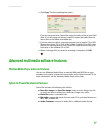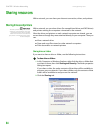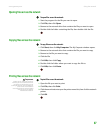
CHAPTER 7: Wireless Networking www.gateway.com
80
Wireless networking
Wireless networking is the latest advance in computer communication. With a
wireless home network, you can use your notebook wherever you like. From the
comfort of your sofa, kitchen, or patio, you can browse the Internet, send and
receive e-mails, transfer files, and use your printer.
You can even browse the Internet and check your e-mail when you are away
from your home by connecting to public hot spots commonly available in
airports, libraries, book stores, and coffee shops.
For the notebook user on the go, wireless networking just makes life easier.
A wireless network uses radio waves to communicate. Typically, a wireless
network is made up of an access point, a cable or DSL modem (for Internet
access), and your wireless computers.
An access point is a small electronic device that serves as the central control
point for your network. You connect your modem to the access point, set up a
network connection, then browse the Internet, send e-mail, share files and
folders with other networked computers, and access other devices, like a printer
or scanner.
Buying wireless equipment
Tips & Tricks
When you buy your access point, make
sure it has:
• IEEE802.11g support. 802.11g is the
fastest method for wireless
communications. 802.11g is compatible
with the older IEEE802.11b format but
not with the competing IEEE802.11a
format. Make sure that you get the
correct format that matches your
notebook.
• DHCP server/dynamic IP address
assignment capability that makes it
easier to set up and access your network.
• Internet security features like a firewall
to keep intruders out of your network.
• Wireless security features like
SecureEasySetup™ or 128-bit WEP
encryption.
If you are not sure what to buy, check out
Gateway’s accessory store at
accessories.gateway.com
.
For a wireless network you need:
■ Your Gateway notebook with built-in wireless networking
■ A broadband Internet connection
■ An access point
Cable or DSL
modem
Access point


















